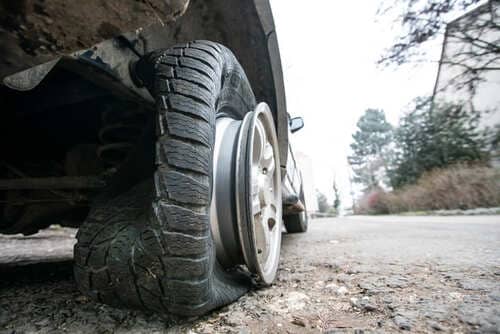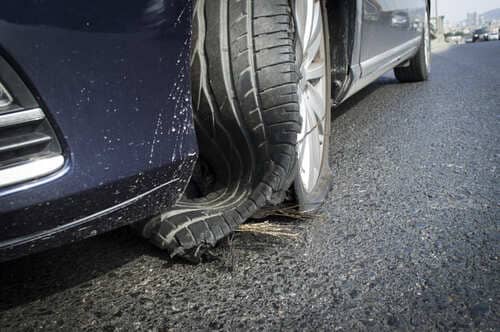
What to do if your tyre bursts while driving
A burst tyre is enough to spoil anyone’s day, especially when driving at high speeds down the motorway. The key here is to not panic and to follow the standard safety procedure. Learning these simple safety and maintenance tips will help you to maintain your composure in an emergency or, better still, avoid a tyre blowout in the first place.
What causes a tyre to blow out?
An exploding tyre is generally the result of abnormally high temperatures inside the tyre or damage due to defects, pressure, or a collision, causing it to rupture. However, these issues don’t tend to crop up out of nowhere. There is usually some kind of neglect involved.

Top tyre blowout causes:
- Incorrect tyre pressure
Both over inflating or under inflating tyres can leave them more vulnerable to blowout damage. Underinflation increases friction and makes it more difficult for the tyre to move along the road surface, leading to overheating. The lack of air pressure causes the tyre walls to flex and increases the tread’s contact with the road.
In contrast, adding too much air pressure can cause the tyre to over expand in high temperature conditions and wear unevenly along the tread. The best solution is to regularly check the tyre pressures and keep them within the pressure ranges recommended by the car manufacturer, particularly before long car trips.
- Exceeding the maximum speed rating
All standard car tyres have markings along their sidewall indicating their dimensions and specifications. This includes the maximum speed for the tyres, known as the speed rating.
Example: 195/55 R16 87 V
Check an online speed conversion chart to decode your tyres. In this case, the V represents a maximum speed of 149 miles per hour. Exceeding this maximum speed over long distances will make your tyres more likely to burst.
- Overloading the vehicle
Loading your vehicle beyond the weight restrictions specified by the manufacturer will also put excessive stress on your tyres and is considered a serious safety risk. Pay attention to the load index. This is indicated by the two numbers before the speed rating, e.g. 91 V.
- Using the wrong kind of tyres
Make sure not to use winter tyres for your car in warm weather conditions or summer tyres in freezing conditions. The rubber compounds of seasonal tyres are only able to withstand certain temperatures. As a rule, you should switch to summer tyres when average temperatures exceed 7°C and winter ones when they drop below 7°C.
What should you do if your tyre bursts while driving?

First of all, DO NOT brake suddenly as this could cause you to lose control of the vehicle. Instead:
- Grip the steering wheel firmly
- Slowly decelerate
- Try to drive in a straight line
- Turn on the hazard lights
- Pull over in a safe spot
- Call a breakdown service if necessary
Installing the spare tyre
Tools required:
- Wheel wrench
- Wheel chocks
- Car manual - just in case
- Car jack
- Reflective jacket
- Protective gloves
- Take the spare wheel and equipment out of the car boot.
- Place chocks on the front or rear wheels (opposite axle to the exploded tyre) to secure them.
- Loosen the wheel nuts while the car is on the ground using the wrench (turn anticlockwise).
- Jack up the car at the designated jacking point. Use jack stands for support if necessary.
- Remove the wheel nuts and carefully detach the tyre – make sure to hold it up firmly as you remove it.
- Install the spare wheel. Install the wheel nuts and tighten them by hand.
- Lower the vehicle to the ground and remove the jack.
- Tighten the nuts with the wrench to the recommended torque (see car manual).
- Check the tyre air pressure.
TOP products on the subject:




































